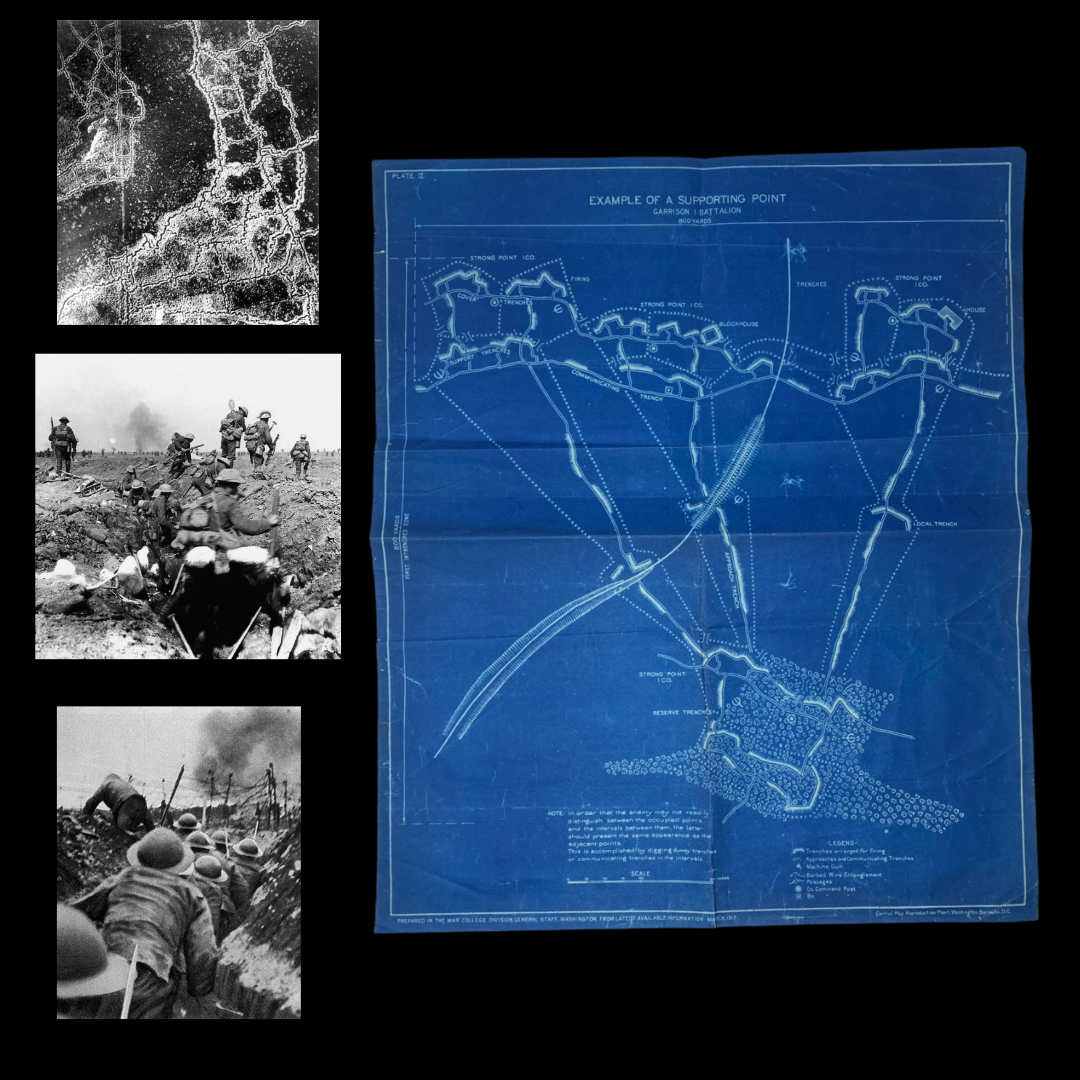1917 Dated - Plate II - A.E.F. Engineer 'SECRET' Detailed Trench System Layout and Construction





























1917 Dated - Plate II - A.E.F. Engineer 'SECRET' Detailed Trench System Layout and Construction
Size: 17 x 20 inches
This incredibly rare World War I blueprint dated March, 1917 was produced less than 2 months after the infamous Zimmermann telegram (January 19th, 1917) which sparked the U.S. involvement into WWI. The Zimmermann telegram is passed along by the British to the Americans and is then made public, causing an outcry from interventionists in the U.S., such as former president Teddy Roosevelt, who favor American military involvement in the war. This blueprint set the foundation of trench warfare for the A.E.F. forces as it was on April 2, 1917 tha President Woodrow Wilson appears before the U.S. Congress and gives a speech saying "the world must be made safe for democracy" then asks the Congress for a declaration of war against Germany.
This blueprint is titled “Example of a Supporting Point - Garrison 1 Battalion - 800 Yards’ and is marked ‘PLATE II’. This blueprint was printed by the ‘Central Map Reproduction Plant Washington Barracks DC. What makes this original A.E.F. blueprint so rare is the SECRET designs and blueprint layouts of how to properly construct trenches across the front line. This is one of the most detailed blueprints of a trench system that the American Expeditionary Force ever produced. The legend details: trenches arranged for firing, approaches and communication trenches, machine gun, barbed wire entanglements, passages, command post, and Bn.
The blueprint itself also notes “In order that the enemy may not readily distinguish between the occupied points and the intervals between them the ladder should present the same appearance as the adjacent points. This is accomplished by digging dummy trenches or communication trenches in the intervals.” This was absolutely crucial so that when enemy aircraft flew over for observation and reconnaissance photographs the force would appear larger in a particular area than it may actually be. Creating dummy trenches to impose a larger force was an amazing tactical strategy.
These were absolutely essential for AEF soldiers, engineers, and officers before shipping over to France and serving with the British and French in some of the most deadly operations the world has ever seen.
This blueprint has definitely seen use. Corresponding with other documents brought back by AEF soldiers, this blueprint shows average wear and folding marks. Most of these blueprints were destroyed and denoted as SECRET military intelligence. This was not a common bring back for a soldier to bring home after the surrender in 1918.
Trenches during WWI:
After the Battle of the Marne in September, 1914, the Germans were forced to retreat to the River Aisne. The German commander, General Erich von Falkenhayn, decided that his troops must at all costs hold onto those parts of France and Belgium that Germany still occupied. Falkenhayn ordered his men to dig trenches that would provide them with protection from the advancing French and British troops. The Allies soon realised that they could not break through this line and they also began to dig trenches.After a few months these trenches had spread from the North Sea to the Swiss Frontier. As the Germans were the first to decide where to stand fast and dig, they had been able to choose the best places to build their trenches. The possession of the higher ground not only gave the Germans a tactical advantage, but it forced the British and French to live in the worst conditions. Most of this area was rarely a few feet above sea level. As soon as soldiers began to dig down they would invariably find water two or three feet below the surface. Water-logged trenches were a constant problem for soldiers on the Western Front.Frontline trenches were usually about seven feet deep and six feet wide. The front of the trench was known as the parapet. The top two or three feet of the parapet and the parados (the rear side of the trench) would consist of a thick line of sandbags to absorb any bullets or shell fragments.In a trench of this depth it was impossible to see over the top, so a two or three-foot ledge known as a fire-step, was added. Trenches were not dug in straight lines. Otherwise, if the enemy had a successive offensive, and got into your trenches, they could shoot straight along the line. Each trench was dug with alternate fire-bays and traverses.Duck-boards were also placed at the bottom of the trenches to protect soldiers from problems such as trench foot. Soldiers also made dugouts and funk holes in the side of the trenches to give them some protection from the weather and enemy fire.The front-line trenches were also protected by barbed-wire entanglements and machine-gun posts. Short trenches called saps were dug from the front-trench into No-Man's Land. The sap-head, usually about 30 yards forward of the front-line, were then used as listening posts.Behind the front-line trenches were support and reserve trenches. The three rows of trenches covered between 200 and 500 yards of ground. Communication trenches, were dug at an angle to the frontline trench and was used to transport men, equipment and food supplies.